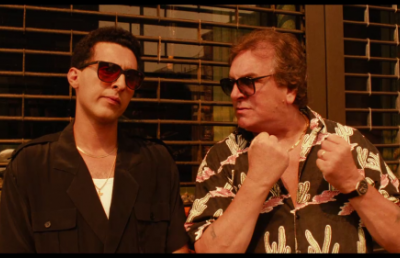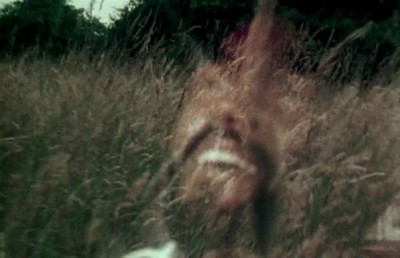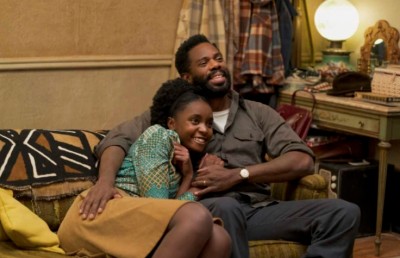The Uniqueness of Bill Gunn’s Ganja & Hess
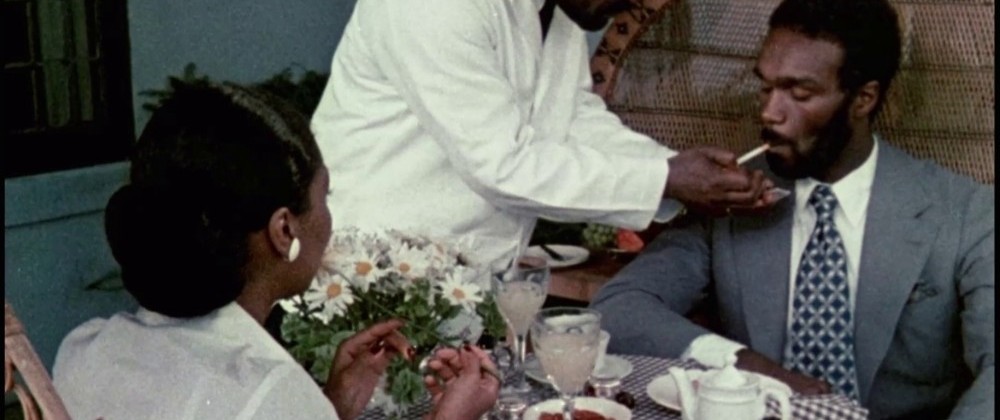
Ganja & Hess
Meda (Bill Gunn)
Dr. Hess Green (Duane Jones)
Ganja Meda (Marlene Clark)
Archie (Leonard Jackson)
Rev. Luther Williams (Sam Waymon)
Ganja & Hess, the 1973 horror/art film by Bill Gunn, is an outstanding piece of outsider art. With Ganja & Hess producers Quentin Kelly and Jack Jordan wanted director Bill Gunn to give them a “black” version of the successful Blaxploitation film Blacula, which for them meant the same formula but directed by black director which they assumed would make even more money. Gunn, a literate, smart, cultured person who came from the Theatre and the literary arts did not accept that as a starting template. His design was more in keeping with his sophisticated aesthetic tastes. Supported by creative producer Chiz Schultz, who would play an important role in bringing the original version of Ganja & Hess back to digital life many years later, instead made an original and unique horror film, which expresses a complex, challenging view of American-African culture the likes of which had never been on American screens.
People that know black horror —academics, historians, especially black scholars— really love this film and recognize the importance of it and the importance of what Bill Gunn was trying to achieve, something wholly different from Blaxploitation films that came before it. Whereas Gunn may not have been consciously working out a “Black Film Aesthetic”, let alone a “black horror film aesthetic”, it is clear that he was trying to deal with an African-American experience different from the one normally displayed (on the rare occasions it was) in American cinema, in the sense of confronting contemporary African- American Christian roots with pre-Christian African roots. Contentious or daring content alone is usually enough to alienate the mainstream, but the defining characteristic of Gunn’s film is not just the content (duality of a non-linear pre-Christian African worldview vs. a linear, Christian worldview), but the presentation of the content –the style– which informs the approach to both character and narrative structure.

Marlene Clark and Duane Jones
One of the qualities which makes Ganja & Hess so fascinating is the presentation of the characters. Unlike conventional narrative cinema where characters are more or less clearly defined by psychological motivation, love interest and personal goals, the three main characters in Ganja & Hess, the aloof, anthropology professor Dr. Hess Green (Duane Jones), his newly assigned research assistant George Meda (Bill Gunn) and Meda’s wife, the sophisticated urbanite Ganja Meda (Marlene Clark), resist any such easy markings. They display unstable behaviour, fluidity of thought, and ambiguity of intent. A fourth very important character is the Reverend William (played by soul singer Sam Waymon), whose presence in the film as a character, as a narrator and as a musical composer cannot be overestimated. Any comprehension of the characters is compounded by Gunn’s experimental approach to narrative. These elements –the complex character formation, the non-linear narrative structure and the haptic visuality—form the film’s overall aesthetic.
Dr. Hess Green, professor of archeology, is tall, handsome and slightly standoffish. Oddly enough, Duane Jones was an English and French literature professor himself at that time, and like Bill Gunn, his promising career was cut short by a premature death at a relatively young age, Jones 51, Gunn 59. As the film starts Dr. Hess Green is doing research on an ancient African civilization which was destroyed by a blood disease 10,000 years before Egypt. His research artifacts can be seen adorning his home (one, a dagger will have important narrative value). Hence just by positioning itself narratively in this way Ganja & Hess, is not framing Africans and African-Americans exclusively through the lens of slavery, but in a context where Africa forms part of a rich culture long before Christianity. Dr. Hess is an insular character who lives in a rich white neighborhood, drives a Rolls Royce, has a butler and chauffeur and lives as somewhat of a recluse, preferring his research and artifacts over the company of others (at least this is the impression we first get of him). He has the financial means to do so based on education and career. Even the way he is depicted as a father who sends his son away to the best finishing schools in France shows us an image of fatherhood that we do not see in most black films of that era (and after) where the father figure is either a super tough taskmaster, a criminal, a drug addict, ineffectual or absent (think here of the surrogate father in Barry Jenkins’ amazing Moonlight as a curative distillation of these different father figures).
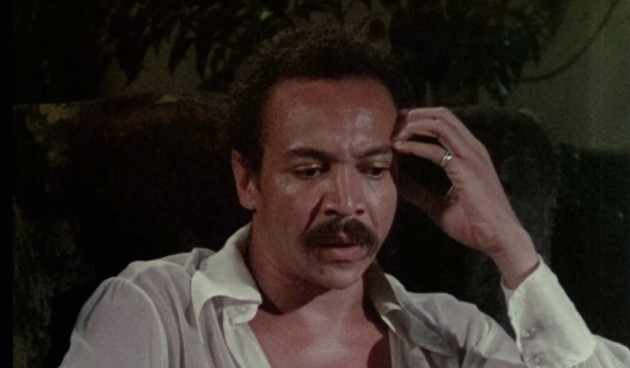
Bill Gunn
Ganja Meda is played by Marlene Clark, a beautiful African American actress who appeared in a slew of low budget horror films (some not without interest) around the period of 1973 and later appeared mainly in television shows. Gunn was familiar with Clark having used her in his unrelease debut marital drama from 1970, Stop!. An interesting side note of her career is that Marlene Clark was married to Billy Dee Williams from 1968-1971. With hindsight we can say that Marlene Clark’s career was stunted by a Hollywood not willing at that time in the late 1960s’, 1970s to conceive of roles for beautiful black women. Her character only enters the film at the 40 minute mark, but makes an instant impression with her style, confidence and regal beauty. She steals many of her scenes with a mixture of cockiness and intelligence. Film scholar Kinitra D. Brooks discusses the zombie film and Black Women in her essay “The Importance of Neglected Intersections: Race and Gender in Contemporary Zombie Texts and Theories” (African American Review 47.4 (Winter 2014): 461-475). Brooks looks at the representation of black women in the post-apocalyptic zombie films as a way to look for intersections between race and gender that are not fully possible with criticism that focuses almost exclusively on the white and/or black male characters. The idea here is that when the question of race enters critical discourse it deals with black men and when the question of gender is brought up it is with respect to the women, gender but not race.
In the Blaxploitation films the black female is often depicted or identified almost exclusively through her superwoman powers and therefore dehumanized, which makes it more difficult for women to identify with. Brooks writes, “It is not enough to simply include black female characters; horror creators must also make them individuated figures woven into the main narrative.” And in Ganja & Hess this occurs in the way Marlene Clark’s Ganja Meda is given her own space, appears first in the title, looks out for herself, and remains strong from a vulnerable place. And most importantly she survives by choosing not to follow Hess’ male lead to suicide but decides to live on with her newly assumed immortality. While Ganja may first strike us as an unsympathetic, spoiled urbanite our impression changes the more we learn about her. Most strikingly in an amazingly photographed long take where Ganja looking slightly off camera tells us her back story about how her mother and parents never loved her and would continually tell her she was a mistake. She learned to loathe her beauty because that was the only nice thing her mother ever said about her. She would refer to herself as a disease and because of that experience she always felt that she had to look after herself. So what ends up being on the surface a negative representation we understand as a powerful form of empowerment where she learned how to always lookout for Ganja, referring to herself in the third person. By extension we could take this to mean how black society has to defend itself against decades of systemic racism.
What is as equally striking as the complex characters is the film’s non-linear and collage-like visual style. The only other African American film from around the same period remotely like Ganja & Hess is Melvin Van Peebles’ Sweet Sweetback’s Baadasssss (sadly I learned of Melvin Van Peeble’s passing as I was writing this). Ganja & Hess also shares a similar marketing problem with Sweet, Sweetback which is sometimes lumped together with blaxploitation, a sub-genre it no doubt influenced but has very little in common with. Likewise Ganja & Hess is a horror film, but is never confined by genre and is in equal measures an art film marked by Gunn’s own idiosyncratic intellectual background as a writer, actor, playwright and poet. My sense at least looking at it with the benefit of hindsight is that Gunn was trying to carve out a unique Black Aesthetic with this film. I am not implying here that Gunn was doing this self-consciously or planning it as a manifesto but that it was a natural result of his varied intellectual and artistic interests.
The cinematographer of Ganja & Hess, James Hinton, is acknowledged as the first black cinematographer to have shot a theatrically released American film. Writer Chuck Jackson elaborates on the historical and aesthetic importance of this in his essay “The Touch of the ‘First’ Black Cinematographer in North America: James E. Hinton,Ganja & Hess, and the NEA Films at the Harvard Film Archive” (Black Camera, Volume 10, Number 1, Fall 2018, pp. 67-95).
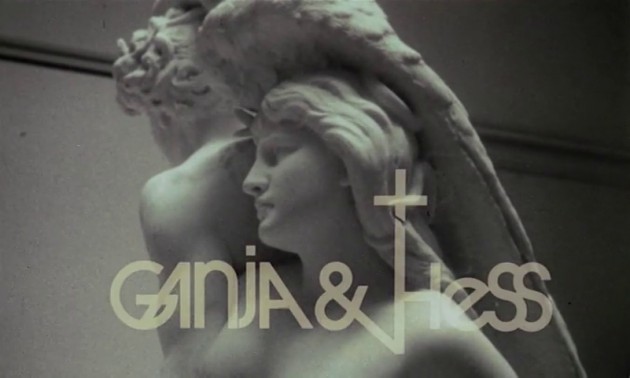
In this essay Jackson suggests that Hinton’s camera and lighting work reflects what film theorists have defined as haptic visuality. Even though cinema is too often defined as an optic art of the visuals, Laura U. Marks in her remarkable book The Skin of the Film (2000) looks at films which also operate with the other senses, like the sense of touch, taste and smell. Most of the films Laura Marks discusses are films of the diasporic, what she calls “intercultural cinema,” by filmmakers who are exiled or living away from home. “And, unlike Western ocularcentrism, which values sight as the greatest epistemological sense, intercultural cinema embraces the proximal senses (smell, taste, touch) as a means for embodying knowledge and cultivating memory” (Donato Totaro, Canadian Journal of Film Studies, Volume 10, Issue 1, March 2001, 106-107).
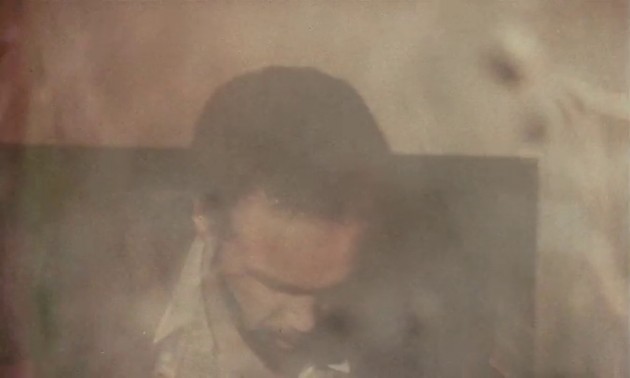
Diasporic filmmakers make films that have a strong attachment to memory, to remembering and recalling their home as part of what makes them who they are. In diasporic films characters think about their parents, siblings, their once familiar home space, the smell of their home, their grandmother’s cooking, the way sunlight broke into their morning window, things that may not have been special then. These filmmakers use haptic visuality to create a sense of who they are, their identity. In a review of the Marks’ book I identified the different aesthetic qualities of haptic visuality as “…synesthetic effects; changes in focus, graininess, under- and overexposure, unclear imagery, and decaying film and video; optical printing and scratching on the emulsion; video effects and formats such as Pixelvision (Fisher-Price toy camera); the use of extreme close-ups, and alternating between film/video mediums. (If I were to imagine a painting analogy, think impressionist and post-impressionist painting as haptic cinema, and 19th realist painting as optical cinema). (Canadian Journal of Film Studies, Volume 10, Issue 1, March 2001, 108).
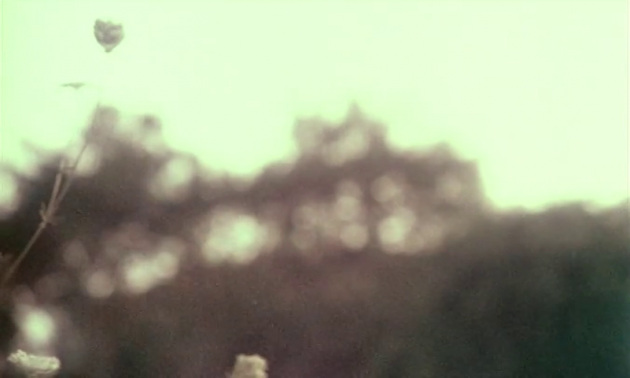
As Chuck Jackson notes of James Hilton’s work, haptic visuality goes a long way in explaining some of the ideas put up on the screen by Gunn and Hinton. For example, by immersing himself in his anthropological research on the African Myrthian tribe Dr. Hess begins to ‘remember’ locations and spaces which Gunn displays with associative editing to shots of a Myrthian Queen walking through the woods. These images are framed through soft focus iris apertures which render a hazy, dream-like feel to them, as if a distant memory. Later Hess appears transported into these same spaces, as if he has been transported hundreds of years into his genealogical past. This haptic visuality is nowhere more apparent than in the lovemaking scenes —which often end up also being murder scenes—where the camera pays up-close attention to the glistening sweat or blood on the skin. In some cases, with shimmering metallic-like flakes on the surface of the bodies. This attention to the body, the skin, the texture and highlighting the texture is something that you get in haptic visuality, with things that are shifting between in and out of focus (like you might get with the autofocus function on consumer model video cameras). I would hazard a guess that Bill Gun in these lovemaking scenes was influenced by Hiroshima Mon Amour (1959, Alain Resnais). Notably the famous lovemaking flashbacks to the Japanese man and the French woman making love in Hiroshima where we get close-ups of their entangled bodies covered in a clay or sand-like substance which suggests nuclear dust.
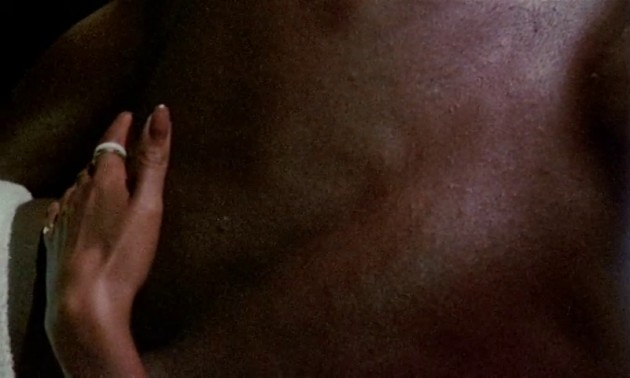
Another quite unconventional aspect of Ganja & Hess is the scarce attention Gunn pays to orthodox narrative concerns such as a plot which keeps the audience in suspense over how events and actions will unfold. Between expository intertitles and the voice-over of Hess’ butler Rev. Luther William (played by soul singer Sam Waymon), we immediately learn that Dr. Hess Green is an anthropologist studying an ancient Nigerian Myrthian society who practiced blood drinking, and that Dr. Hess Green was stabbed three times by a stranger (George Meda, played by Gunn) which made him addicted to blood (nothing is added as to whether he died or not). In the beginning, we see a close-up shot of George Meda pointing a gun at the mirror which comes from his suicide scene later in the film where Meda shoots himself after stabbing Dr. Hess with the Myrthian dagger. These are forthcoming events which we have not yet seen, denying us the usual suspense we might find in a horror film. Gunn’s cutting here recalls Nicolas Roeg’s modernist films around this time (Performance, 1970 co-directed with Donald Cammell, and Walkabout, 1971) where he would interrupt scenes with flash frame edits from other parts of the narrative that only make sense retroactively.
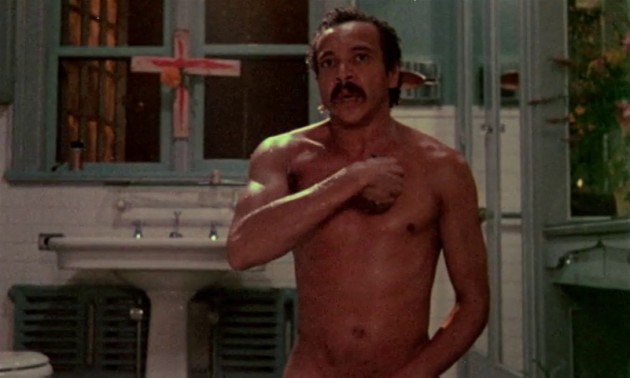
This nonlinearity is also lined up with the duality in the film between the pre-Christian African civilization and the Christian civilization that you see represented in the film through The Rev. character William, who moonlights as Hess’ chauffeur, and the several important scenes in the Baptist church (shot in a New York church near where Gunn lived). In one of these church scenes Rev. William pleads with Hess to abandon his African roots and adopt Christ as his Savior. This aligns perfectly with the non-linearity of Gunn’s style, in that Christianity adopts a linear worldview. You’re born, you live. If you’re lucky, you don’t suffer too much, and then you die. And if you’re a good person, you live in eternal paradise, a straight, linear path from birth to the afterlife. That’s the Christian narrative path that the Rev. is on, and that he wants Hess to join. And then outside of that is the African world view explored in the film which is a reflection of many non-Christian religions which adopt a non-linear world view. If you think of the Australian Aboriginals, they have Dream Time, which is a non-linear sense of History. Native Americans also have cyclical sense of time. A lot of Asian nations have a worldview or spiritual view that is cyclical, based on the rhythms and temporality of nature rather than a linear timeline. In a sense the film presents the Christian world view proposed by Rev. William as one narrative possibility (Hollywood if you will) and the pre-Christian African as another narrative possibility (a Black Film Aesthetic, perhaps?).
But where does Bill Gunn position himself? As a filmmaker he is adopting the non-Christian viewpoint as his main structuring principle. However, the characters in the story are poised differently. The Rev. William who also moonlights as Hess’ chauffeur, is an easy character to read, unlike Ganja and Hess. Those two are positioned somewhere within William’s linear Christian path. Gunn leaves it up to the viewer to decide what to think about the story. Dr. Hess Green, George Meda and Ganja Meda are complex characters with varying reads on this duality. While Hess is caught between the two positions, George himself is confused and possibly mentally unstable yet is the character who indirectly thrusts Hess into the Myrthian past by cursing him when he stabbed him with the dagger. Ganja comes into the picture as a headstrong woman ready to manipulate any situation to her benefit. One assumes based on her appearance as a modern, sophisticated women that religion has no hold on her psyche. However, once she gives herself over to Hess she is cursed by the same bloodlust and under the same Myrthian ‘spell’. However, where Hess is subsumed by guilt and decides to follow his ancestral path to save his soul through suicide by the shadow of the cross, Ganja does not follow him.
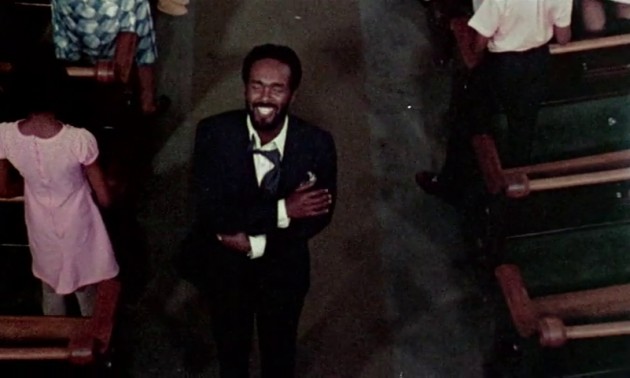
Dr. Hess attempts Christ
This duality in the form of a spiritual battle is played out in the final scene. Hess goes back to the church and tries give himself over to Christ. The Reverend tells him to give his life to Jesus in a Baptist mass with a full gospel choir and fervent prayer. While Hess is giving himself over to Christ the scene intercuts to a slow-motion, soft focus shot of Hess running in the same pastoral, forest landscape of the Myrthian Queen (played by Mabel King) sequences (what Benshoff refers to as “the pre-Christian garden,” 44). The clash from Church to Myrthian past exemplifies a theme noted by Gunn of the way Blacks are consumed between these two different historical positions: pre slavery African roots and their post slavery Christian roots. This final scene is again set off against a dark black background with a hanging cross and the single light source which will cast the fatal shadow of the cross over Hess’ heart, which makes it feel like a living Caravaggio painting. After Hess falls to the ground we get this wonderful image of autumnal leaves drifting across the wooden floor. Perhaps another indication of the noted duality of the African roots set against and the (Western) hardwood floors.
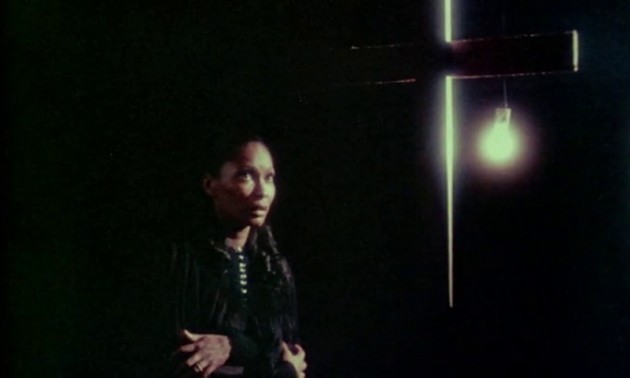
But Ganja does not follow Hess to suicide. Instead she takes hold of the immortality that Hess passed on to her. Hess is dead, Ganja lives on. A striking closeup of Ganja filmed through the red cross on the window of the ambulance taking Hess’ body away forms a final visualization of the African vs. Christian thematic of the film.
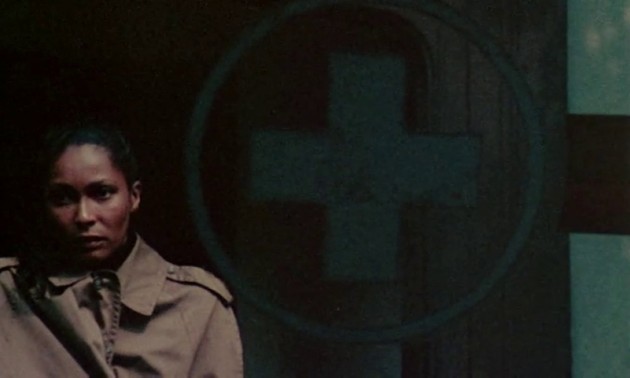
In the enigmatic ending we see the young lover from the dinner sequence who was killed and carried out into the fields emerging from the pool, nude. He begins to run toward the house in slow motion and is trapped in a freeze frame leaping over the fallen corpse of Hess’ butler Archie (we can only assume a victim of Ganja). This cuts to a series of zoom in close-ups and jump cuts from different angles of Ganja at the window, caught in a Mona Lisa smile.
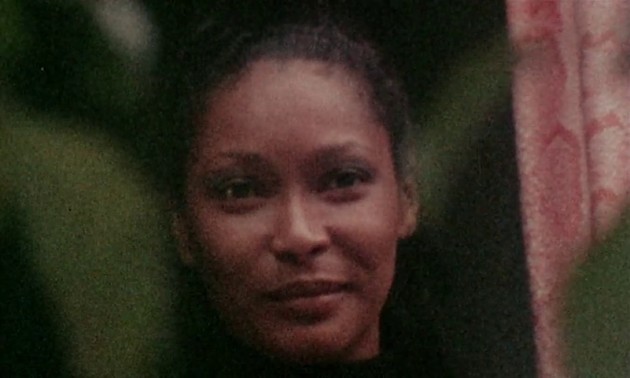
Manthia Diawara and Phyllis R, Klotman write, “ “Ganja is a contemporary black woman. She is tired of being subservient to the church and to black men. She’s glad that Meda and Hess, the self-destructive artist and the bourgeois patriarch, are gone.” In his queering of the film Benshoff adds: “She survives Hess’s crisis of suicide and proudly carries on her monstrously queer Afrocentric existence.” In Diawara and Klotman’s progressive read of the film the Rev. William eschews his African roots for a Christian linear worldview. And as they note, the scenes of the Minister are shot in a more conventional, documentary style. In the tradition of Robin Wood’s ‘return of the repressed’, because vampirism is tied to Africa it is the Other. Hence the deaths of Meda, who brought the curse onto Hess by stabbing him with the Myrthian dagger, and the cursed Hess equals a return to the Christian Normality. But by ending on Ganja, who is this modern black woman, the queerness of her adopted African American existence also survives. And with it the curse and power of Hess. So there are two narratives that seem to survive in the end: the Minister’s Christian linear view of life (since he remains alive) and Ganja’s more selfish (“Always look out for Ganja”) queer Afrocentric existence. This would explain how she has literally taken over Hess’ space, her gaze lingering out from his window.
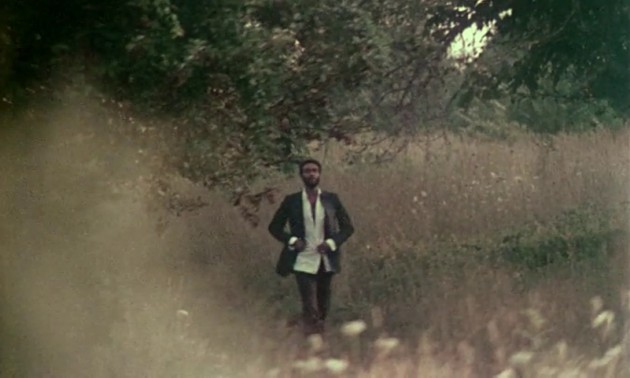
The dinner scene where Hess and Ganja have a young black man over for dinner casts an interesting shadow on the ending. The young attractive black male (Richard Harrow) becomes the classic victim invited by the vampire couple to be consumed for blood, but the scene is highly eroticized. After dinner the man and Ganja have sex before she performs her first kill. What’s interesting to speculate here since we see the same man returning back to Ganja in the final scene of the film is that we could understand how Ganja might prefer this man over Hess. Not only is he younger but he would be much easier for her to manipulate and control as he is not a sophisticated, cultured and educated man like Hess, but a working class proletariat who works as a volunteer at a local social network group. This would align with Ganja’s elitist attitude to lower classes, as evidenced by her condescension toward Archie (whom she most likely killed). This also fits in with the class bias of many vampire or Dracula tales, like Countess Bathory, the aristocratic who bathes in the blood of lower class servants in an attempt to stay young. Ganja’s classicist behaviour is evident early on in the hilarious breakfast patio scene, with Ganja flagrantly condescending to Hess’ butler Archie, bossing him around and taking advantage of her status as a guest and her class privileges.
Dr. Hess seems displaced from his society, living well in a lush estate but removed from any meaningful human interaction. And when he is stabbed by the Myrthian dagger and then reborn as a blood addict his behaviour seems to accentuate his upper class existence. To satiate his bloodlust Hess feeds on the underclass, preying on criminals, pimps, and a prostitute. His addiction leads him to frequent seedy urban spaces and locations he would never visit otherwise. The behaviour of all the major characters give off a sense of cultural displacement, which is something Gunn has said about the film himself.
This sense of cultural displacement plays out in one of the most harrowing scenes in the film, Hess Green’s attack on the prostitute in her low rent room. A well-dressed Hess feigns sexual purchase with a young prostitute who is holding her baby on the steps of her apartment building. They enter the building and the scene cuts to Ganja discovering her husband’s corpse in the walk-in freezer. We cut back to Hess to the aftermath of the murder. The shot is framed as if to mock a classical Christian icon. Hinton places the camera in a high angle long shot distance similar to Meda’s bathroom suicide. The woman is lying inert on the bed with one leg exposed, like the Virgin Mary with blood on the bedsheets over her breast. As if to make this allusion obvious, we see a large Virgin Mary with Christ painting on the back wall above the bed. It’s a quite beautiful composition. On the sound track we hear the jaunty theme music of a Laurel & Hardy film and the off screen sound of a baby crying. Gunn and Hinton estrange the moment by slowly tilting the camera in a pendulum pan as Hess leaves the frame and the image shifts to an out of focus establishing shot of the next location.
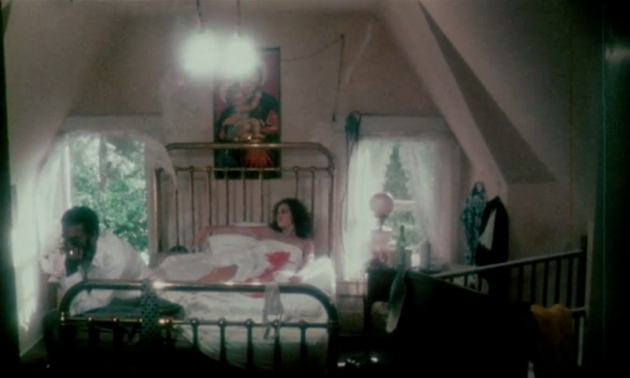
Gunn leaves us with many questions following this scene. Is the young woman really dead, or is she cursed? What’s going to happen to the poor baby. Is Gunn referencing the convention of Dracula tossing a baby to his vampire brides? Although we are spared the sight of the actual attack, that slow rocking of the camera makes it perhaps more nauseating than if you had seen the attack.
The film offers many other great allusions to classic art, like the early scene where George and Hess first meet and have dinner at Hess’ home. The men continue their dinner talk outside in the backyard. Under a dark night sky we hear George but only see his legs dangling from the branch he is seated on. Next to his legs framed behind Hess’ head is a noose. George’s thoughts revolve around death and suicide, which coupled with his dangling legs, the tree and the noose eerily invokes the many lynchings of the late 19th century and early 20th century. The scene cuts back to inside the home, where a shirtless George is framed next to a large Renaissance painting. A candle casts a soft light onto the scene. The somber lighting recalls the great Caravaggio, a painter whose realistic approach to religious subjects sparked controversy among the Catholic Church. This same naturalistic approach to his subjects can be seen in Gunn’s style. For example, in this scene nose mucus is visible dripping onto George Meda’s moustache, which makes him appear pathetic. Caravaggio brought his religious subjects literally down to earth by foregrounding the body.
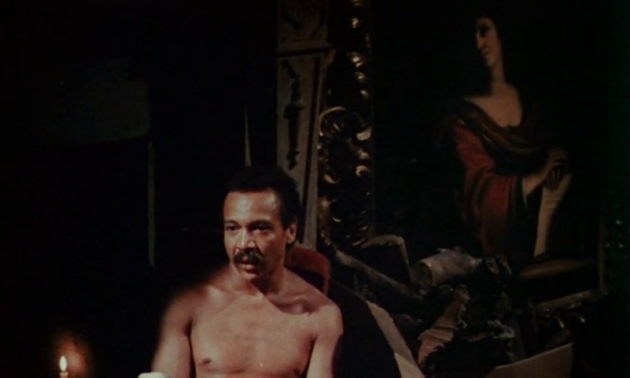
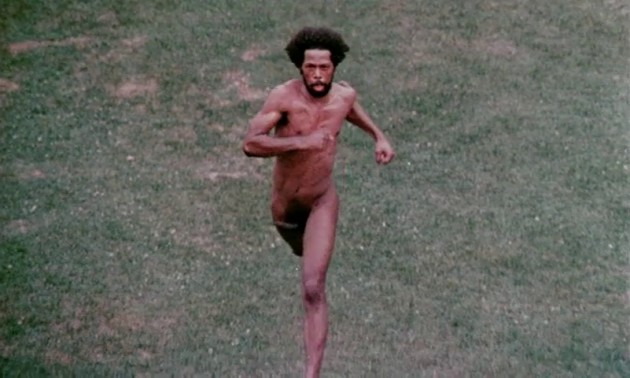
Caravaggio was criticized for showing Christ’s feet. Likewise Meda is shown shirtless here and Gunn features full frontal (black) male nudity in two scenes, Meda’s suicide scene and the scene near the end where the (dead?) nude man from the dinner scene is running toward the camera in slow motion, with his penis swaying in its full glory!

These two scenes, as are many others, are lit in near total darkness, which raises another interesting issue which demonstrates how aesthetics and politics overlap. In the commentary track on both the special edition DVD and Blu Ray of the film DP James Hinton chooses this scene to discuss lighting shots for the darker skins of black actors. Hinton, who may have been intimidated by his lack of experience, went against his lighting man’s suggestion that they darken Bill Gunn’s skin tone and hues to make the black actors look alike. Hinton argued that he did not want to homogenize the black skin tone. As he said, there are black, brown and darker brown skins tones among African Americans, and he did not want to erase that diversity. Would a white cinematographer in the early 1970s have thought the same way?
In terms of allusions, I wonder if perhaps Dr. Hess Green sending his son to a boarding school in France was a reference to the many Black artists who went to Paris to escape domestic racism, like Josephine Baker, Billie Holiday, Charlie Parker, Dexter Gordon, and the great writer/activist James Baldwin, who moved to France in 1970 and lived there until his death in 1987. The lawn party scene is an example of the sort of environment that African Americans would not see themselves in at that point in time: a party where many upper class, educated and multilingual African Americans get together to talk, listen to classical music, sip good wine and socialize. And I wonder whether this lawn scene had any influence on the lawn seen party in Get Out?
The noted tension between Pre-Christian African and Christian religion is set up right from the opening credit scene, where we hear Sam Waymon singing about the Myrthian civilization over images of Greco-Roman statuary. Even the film’s title card has a cross formed out of the letter ‘H’. Chuck Jackson cleverly observes that these shots of the statuary, while appearing to be static actually have slight jittery movements, which introduces the haptic visuality. Meanwhile the instability of the framing is an indication of Hess’ own oscillation between his African roots (thrust into him by the dagger) and his contemporary Black American reality. In some of these statue shots bodies appear in contorted positions, which in their texture and formation foreshadow some of the later love-making scenes. Also adding to Jackson’s point about haptic visual is the graininess of the film image which comes from it being shot on Super 16mm and blown up to 35mm for theatrical projection. This thematic duality of Pre-Christian African and Christian culture runs throughout the sound as well, with the score alternating between Western blues/gospel music which reflects the Christian world view and the loud, grating experimental sounds that represent Hess’ ancient Pre-Christian Myrthian bloodlust.
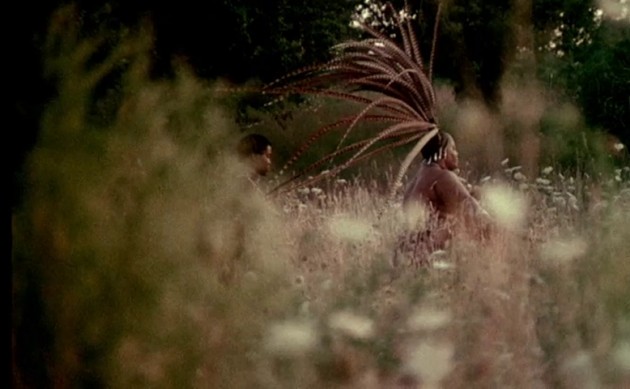
Hess’ archaeological research of the Myrthian civilization can be seen as a manifestation of his own unconscious repression of the African part of his roots. Meda is the person that returns him to these roots by killing him and infecting him with the Myrthian blood curse: the blood that is part of the African blood, the mythology of bleeding the slaves and the cursed blood and the blood that the vampire requires to sustain itself. Through the Baptist Church scenes we get the blood of Christ, the wine during the Catholic mass as the symbolic Blood of Christ. As Waymon cryptically sings, “blood is the thing, the thing is the truth, the truth of the thing.”
George stabbing Hess with the Myrthian dagger, ‘diseased’ from that ancient culture, is the equivalent of being bit by a vampire. There is that division right from the beginning that the Myrthian culture represents the blood lust of vampirism. In the song sung by Rev. William (Sam ) we get the back story of the ancient Myrthian civilization and how it was steeped in a Pre-Christian blood drinking. The Myrthian bloodlust was satiated by bleeding thousands of slaves, which cursed them. Whereas the blood that is drawn as the body of Christ is a form of salvation. So again, blood figures into this pre African and Western split. Hess became addicted and could only be freed from his curse –that is be killed—by the dark shadow of a cross cast over his heart. But since the culture was pre-Christian, this form of salvation could only come after Christ.
If you accept Harry Benshoff’s reading of the film’s blood drinking as a metaphor for capitalism, then the way Hess isolates himself and drinks only the blood of the poor, a prostitute, a pimp, the volunteer student invited to dinner, can be read as a critique of how he has divorced himself from the broader American black experience. The way he, as a member of the black upper class, has lost contact with the black majority (following on with this reading I see a lineage to Jordan Peele’s Us (2019), which also plays with this theme).
In their invaluable essay “Ganja and Hess: The Savaging and Salvaging of an American Classic,” Video Watchdog, No. 3, Jan/Feb, 1991, pp. 38-57, Tim Lucas & David Walker write that the film is about alienation, enemy, religious and cultural identity, hunger, addiction, power -it is all about all of these things, often in ways that are filled then articulated (41). Later they add, “ it is all about the devouring all black culture by the dominant white Christian society, the absorption of black artifacts by the white institutions, and the residual effects of the emotional withdrawal or depletion of survivors of a distinct or depleted cultures.”
This Lucas and Walker article provides a great production history on the film. Lucas and Walker reveal that the film had a very short run of about a week in New York City with poor box office but played at the 1973 Cannes Film Festival during the critic’s week. The film received a standing ovation and legend has it the applause began long before the film ended. French critics lavished the film with praise while the response from American representatives was condescending. The pioneering black actress singer Josephine Baker reportedly spent nearly half an hour singing the film’s praises in an effort to challenge the American critics for not supporting Ganja & Hess.
Original producers Kelly and Jordan sold the film off to a second distributor named Heritage Enterprises who hired post production specialists FEMA to re-edit the lengthy film to more exploitable double bill proportions, titled Blood Couple. Their goal was to streamline the narrative, make it linear and place emphasis on the violence and sex. They took footage that was shot but not used by Bill Gunn and laid out the story in a more linear fashion and to emphasize the sex and violence. They marketed this re-edited version, retitled as The Blood Couple, as a type of a B-Movie, Drive-In film.
Lucas and Walker argue that Blood Couple should be considered as its own film, an alternate version with its own particular qualities. In some cases it includes shots and scenes not present in the Ganja & Hess version. And some scenes that are in both versions have slight variations. For example in the above described scene where Hess kills the prostitute, the sound of the baby is removed from Blood Couple. In some cases scenes have very slight variations. The shot of the camera tracking the blowing leaves on the floor after the suicide is the final shot of the film in Blood Couple. The directing credit for Blood Couple was given to a New York based film doctor by the name of Fima H Noveck. Blood Couple runs 33 minutes shorter but includes approximately 15 minutes of footage not used in the director’s cut. Much of this footage tries to play up the vampire theme and provides more information about the Myrthian dagger which appears only in the opening intertitles of the director’s cut. According to this article there was no new footage shot for Blood Couple, but some of the scenes were recut, different takes were used and some of the footage was given a solarization effect.
Thankfully, producer Chris Schultz owned the rights to the original cut of Ganja & Hess and they were able to track down a 35-millimeter print to work from to go back to the original version. Both versions are available for viewing on the special edition DVD and Blu Ray, with a wonderful commentary track with producer Chiz Schulz, DP James E. Hinton, actress Marlene Clark, and Sam Waymon.
While Ganja & Hess is not necessarily a scary film (indeed not all great horror films are) there are parts where it’s very disquieting and very unnerving. Gunn eschews the usual jump scares or shock edits and has left us with an art horror film much more meditative and introspective which still feels ahead of its time. In that respect it’s legacy is hard to gauge and is felt more in its growing critical reputation which is a by-product of the many black film and cultural critics who have long sung its praises, joined by younger black film critics. The growing commercial power of black horror, led by the lightning rod Jordan Peele, and the many writers, critics and artists in front and behind the scenes of the excellent, groundbreaking documentary Horror Noire is also a factor in the increasing visibility of Ganja & Hess.
PS: If you are interested in the concept of haptic visuality, I recommend you watch my audio-visual essay “A Meditation on Haptic Visuality in Bill Gunn’s Avant-Garde Horror, Ganja & Hess” in this issue.
Bibliography
Benshoff, Harry M. “Blaxploitation Horror Films: Generic Reappropriation or Reinscription?” Cinema Journal. Vol. 39, No. 2 (Winter, 2000), pp. 31-50
Brooks, Kinitra D. “The Importance of Neglected Intersections: Race and Gender in Contemporary Zombie Texts and Theories.” African American Review, 47/4 (Winter 2014), pp. 461-475.
Diawara, Manthia & Phyllis R. Klotman. “Ganja and Hess: Vampires, Sex, and Addictions.” Black American Literature Forum. Summer, 1991, Vol. 25, No. 2, Black Film Issue (Summer, 1991), 299-314
Jackson, Chuck. “The Touch of the “First” Black Cinematographer in North America: James E. Hinton, Ganja & Hess, and the NEA Films at the Harvard Film Archive.” Black Camera, Volume 10, Number 1 (Fall 2018), pp. 67-95
Totaro, Donato. “The Skin of the Film: Intercultural Cinema, Embodiment, and the Sense,” by Laura U. Revue Canadienne d’Études cinématographiques / Canadian Journal of Film Studies, Spring 2001, Vol. 10, No. 1 (Spring 2001), pp. 106-109.




